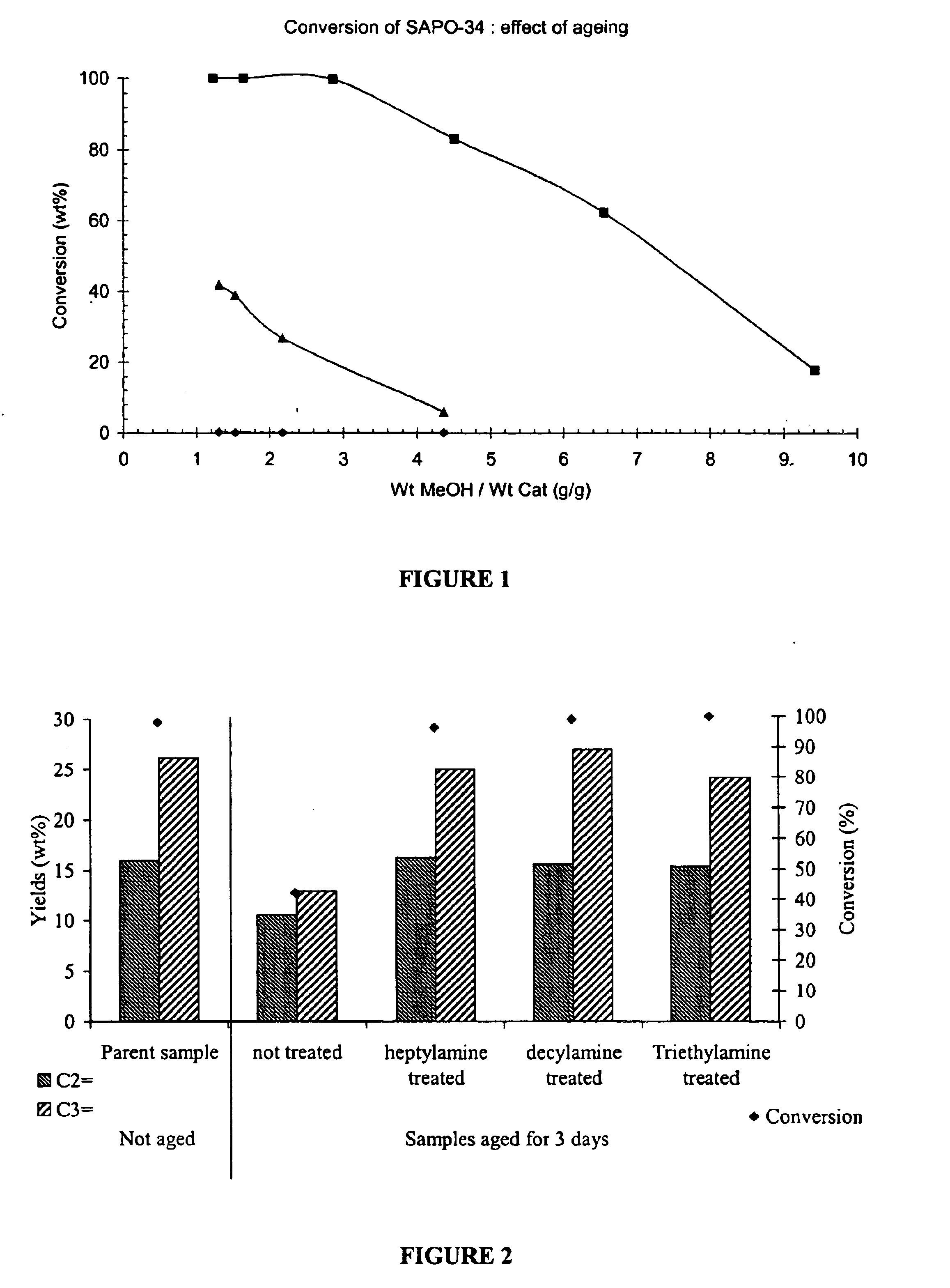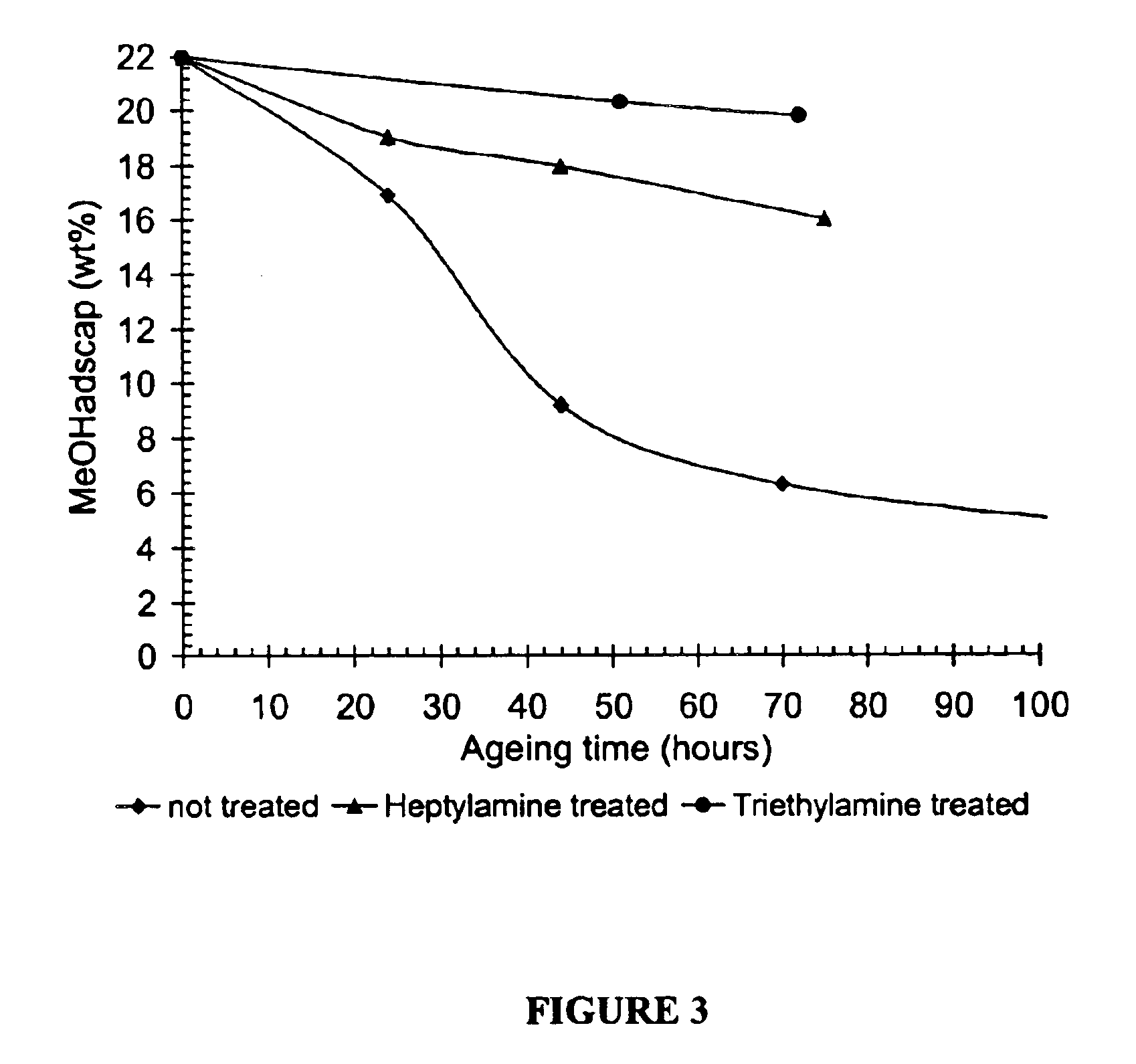Treatment of acid catalysts
a catalyst and acidic technology, applied in the field of acid catalyst treatment, can solve the problems of affecting the stability of the active sapo-37 molecular sieve, affecting the efficiency of the acid catalytic site, and the loss of catalytic life, in some instances irreversible, to achieve the effect of easy removal
- Summary
- Abstract
- Description
- Claims
- Application Information
AI Technical Summary
Benefits of technology
Problems solved by technology
Method used
Image
Examples
example 1
Preparation of SAPO-34
[0178]SAPO-34 was crystallized in the presence of morpholine (R) as templating agent. A mixture of the following mole ratio composition was prepared:
0.6 SiO2 / Al2O3 / P2O5 / 3R / 50 H2O
[0179]80.1 g of Condea Pural SB was mixed with 422.0 g of deionised water, to form a slurry. To this slurry was added 135.6 g of phosphoric acid (85%). These additions were made with stirring to form a homogeneous mixture. To this homogeneous mixture 53.2 g of Ludox AS40 was added, followed by the addition of 157.2 g of a morpholine (R) with mixing to form a homogeneous mixture. To this homogeneous mixture was added 1.97 g of a seeding slurry containing 8.68 wt % zeolite chabasite crystals.
[0180]This homogeneous mixture was crystallized without agitation in a 1 liter stainless steel autoclave. The mixture was heated to 175° C. in 6 hours and kept at this temperature for 48 hours. This provided a slurry of crystalline molecular sieve. The slurry was evenly divided over 2 one liter bottle...
example 2
Treatment and Ageing of SAPO-34 with Amines
[0181]The SAPO-34 was activated (calcined) prior to the modification. Calcination was performed in a muffle furnace at 625° C. for 4 hours under ambient air (heating rate: 5° C. / min). The calcined SAPO-34 was transferred into a vessel and mixed with heptylamine, triethylamine or decylamine and then stored in contact with the amine for a period of 30 minutes to 60 minutes under an inert atmosphere of nitrogen. The treated SAPO-34 was then recovered from the amine and allowed to dry under nitrogen at room temperature before testing. All of these amines have kinetic diameters, which are greater than the diameter of the pores of the SAPO-34 molecular sieve.
Aging of the SAPO-34
[0182]The SAPO-34 with and without nitrogen containing compound was hydrated (aged) in a moisture-containing atmosphere (90% relative humidity) for periods of time from less than 1 day up to 3 days. 90% relative humidity was established by a saturated KNO3 solution in an e...
PUM
| Property | Measurement | Unit |
|---|---|---|
| temperature | aaaaa | aaaaa |
| temperature | aaaaa | aaaaa |
| temperatures | aaaaa | aaaaa |
Abstract
Description
Claims
Application Information
 Login to View More
Login to View More - R&D
- Intellectual Property
- Life Sciences
- Materials
- Tech Scout
- Unparalleled Data Quality
- Higher Quality Content
- 60% Fewer Hallucinations
Browse by: Latest US Patents, China's latest patents, Technical Efficacy Thesaurus, Application Domain, Technology Topic, Popular Technical Reports.
© 2025 PatSnap. All rights reserved.Legal|Privacy policy|Modern Slavery Act Transparency Statement|Sitemap|About US| Contact US: help@patsnap.com


